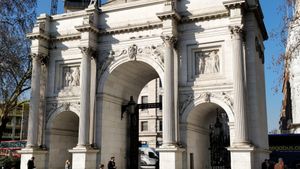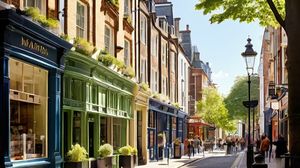
Marble Arch is an iconic historical monument located at the junction of Oxford Street, Park Lane, and Edgware Road in London. It was designed by John Nash in 1827 and initially served as the state entrance to the cour d'honneur of Buckingham Palace. However, it was moved to its current site in 1851 during the expansion of the palace.
The arch is made of Carrara marble, which is known for its high quality and dramatic veining, lending a majestic appearance to this architectural masterpiece. It is adorned with sculptures by Sir Richard Westmacott, though not all the planned sculptures were completed due to budget constraints.
Interestingly, Marble Arch was meant to be larger and more intricately decorated inspired by the Arch of Constantine in Rome, but the plans were scaled back. Additionally, it was relocated because the larger ceremonial processions at Buckingham Palace required a more open space, leaving Marble Arch to stand prominently as a public landmark.
An unusual aspect of Marble Arch is its intimate connection with traffic. It sits on a traffic island and although once intended exclusively for royal use, many Londoners pass by daily, either on foot or vehicle, giving it an unexpected role in modern urban transport design.
A curious urban legend about Marble Arch is that the three small rooms inside were used as a tiny police station until 1968, although other functions included housing the arch's maintenance tools.
Its proximity to Hyde Park means that Marble Arch acts as a historical gateway to one of London's largest and most famous parks. While visitors can't climb the arch, it remains a popular selfie spot, connecting past and present in a single frame.

Making the Most of Your Visit:
If you're visiting Marble Arch, take a moment to notice the intricate details of the sculptures by Sir Richard Westmacott. Some visitors miss these because they're so close to ground level, but they're worth a close look to appreciate the craftsmanship.
The arch is a prime spot for people watching, too. Park yourself on one of the nearby benches and watch the world go by, from tourists snapping selfies to locals heading about their day.
Don't miss the little-known fact that there's a tiny police station (now no longer in use) inside the arch. This quirky bit of history adds an unexpected layer to your visit.
If you're keen on photography, the best time to capture Marble Arch is either early morning or late afternoon when the lighting is beautiful, and you can avoid the harsh midday sun that can cast strong shadows.
Remember, Marble Arch sits at the nodal point of several important roads. Plan your journey wisely to avoid the peak traffic times; it can get pretty congested around here during rush hour.

Visiting Times & Costs:
Marble Arch is open to the public 24 hours a day, as it is situated outdoors and there are no access restrictions. Visitors can freely walk around the area and appreciate the arch at any time.
There is no entrance fee to visit Marble Arch itself. It is a public landmark and free for everyone to access and explore from the outside.
Since Marble Arch is located on a traffic island with pedestrian access, visitors should exercise caution when approaching. It is accessible on foot, but care should be taken to cross roads safely as several busy streets converge at this point.
Accessibility for those with mobility challenges might be somewhat limited due to the traffic and lack of dedicated ramps or accessible routes directly to the arch, though pathways around it can generally be navigated by wheelchair users with some caution.

Address & Map:

Nearby:























